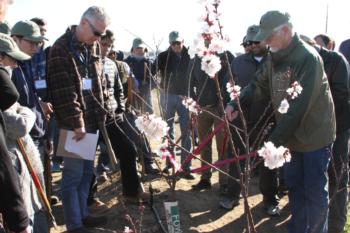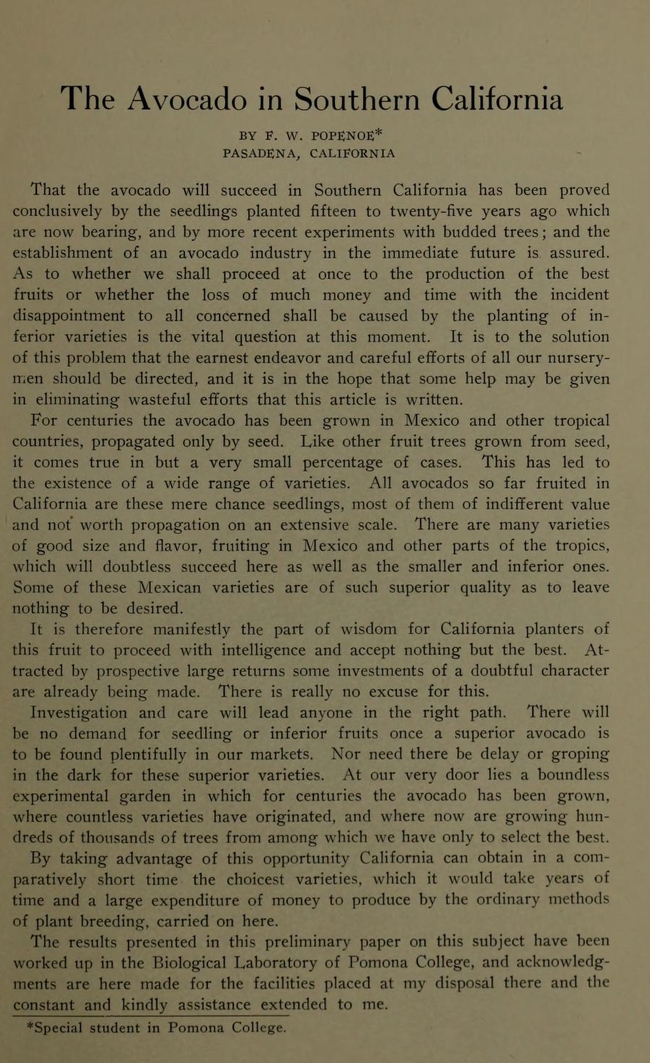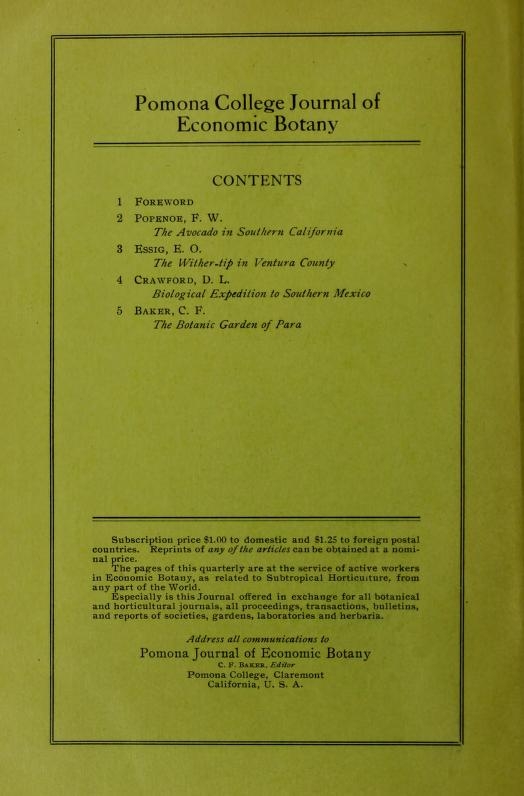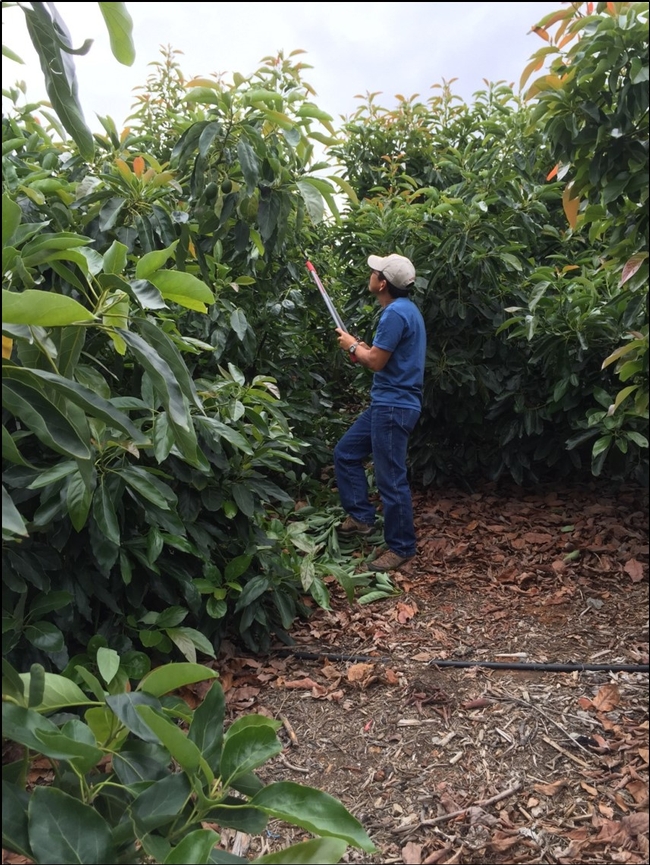
Posts Tagged: horticulture
Cultural Practices to Reduce Pest and Disease in Avocado & Citrus
In many ways our pest and disease management of fruit tree crops are exacerbated by our cultural practices. Avocado and citrus offer some very clear demonstrations of how we manage our trees can lead to reduced pesticide use. From the beginning, our selection of rootstock and scion can help lessen pest and disease problems. In both avocado and citrus we have good rootstocks which can handle problems, such as root rot more effectively than seedling rootstocks. So it is imperative that if you know that drainage will be a problem, starting off with the right, healthy rootstock helps. Also scion selection can have a major impact, as well. For example, ‘Lamb' avocado is much less prone to persea mite than is ‘Hass'. This pest can significantly impact a spray program and planting ‘Lamb' could mean virtually no sprays for this pest. Selling the ‘Lamb' fruit is then the challenge There are similar examples in citrus where one variety is more prone to a pest or disease than another.
Irrigation is probably the most important cultural factor in managing tree disease. Over, under and improperly timed irrigations are the conditions necessary for many root diseases. The Phytophthora spp. fungi are looking for distressed root systems brought on by waterlogging and other stressful situations. Other conditions, such as wetted trunks can also bring on some trunk diseases, like gummosis in citrus and crown rot in avocado. Simply preventing irrigation water on the trunks can limit these diseases. Other diseases, such as black streak, stem blight and bacterial canker in avocado are bought on by soil moisture stress.
Nutrients, especially nitrogen management, has been long known to affect levels of insects, such as scale, mealy bug and aphid. Encouraging lush growth helps sustain these insects, so reducing this growth tends to lower their numbers. Managing when canopy growth occurs can affect pest severity. Avocado thrips build their populations in the spring and moves easily from leaf to fruit causing significant scarring. By promoting leaf growth at flowering time with a nitrogen application, keeps the insect on the leaves and reduces fruit scarring. This also promotes growth that replaces leaves that have been damaged by persea mite. Likewise the incidence of citrus leaf miner damage can be reduced if spring pruning is avoided so that a flush of growth does not occur at the same time as the population is building. Timing of pruning is important in lemons to avoid wet periods of rain and fog to reduce the spread of hyphoderma wood rot fungus when its fruiting bodies are active.
Pruning can change pest pressure by changing the humidity in the canopy, introducing light and changing the climate supporting disease and pests. By making spray coverage more thorough, it also makes for a more effective application. Modified skirt pruning can have significant effects on mealy bug and scale control, fuller rose weevil incidence, ant colonization and snail damage. It's important that the trunk be protected as an avenue of movement for snail and ant control to get the best effects of this pruning. Skirt pruning also reduces problems with such weeds as bladder pod and the ladder effect of brown rot in citrus – fungal propagules splashed from the ground onto low-hanging fruit, which in turn is splashed to higher fruit.
Keeping a canopy clean of dust and fire ash also makes for more efficient biological control. Because predators are slowed in their search, they are less efficient. They also spend more time grooming their sensory organs, and this also slows them down. Parasites such as wasps are actually slowed by the physical abrasion to their tarsi. Dust also creates a drier environment, which is more hospitable to our pest mites. Watering picking rows, roads and even the trees themselves can lessen mite populations. Use of cover crops can also reduce dust and potentially provide pollen and nectar for predators and parasites. Of course cover crops create a whole new set of management issues, such as colder winter orchards and snails.
Finally harvest timing to avoid pest and disease is often overlooked. In avocado, fruit is often set in clusters. Greenhouse thrips love the microclimate created, and if in a size-pick the cluster is reduced, greenhouse thrips will often not be a problem. Harvest timing is also important in citrus. Fruit left too long on the tree can often develop septoria fungal spot. Picking in a timely manner reduces the incidence of this disease.
These are just a few examples of how cultural practices at the right time can reduce pest and disease problems.

avocado pruning
An Apple and An Avocado Both Start With
And Cherry and Citrus both start with "C"
We know neither a lemon or an avocado is a cherry or an apple and a lemon is not an avocado, but fruit trees have lots of things in common: basic physiology. This distinguishes them from annual plants. Pruning, irrigation, fertility management - horticulture - share common principles in tree culture than are different from lettuce culture. Learn some of these big ideas in a focused two week educational extravaganza. Avocados aren't almonds, but you will learn how they are similar and learn how to be a better avocado grower. Become a pomologist!!!!
Principles of Fruit & Nut Tree Growth, Cropping
& Management

2020 Principles of Fruit & Nut Tree Growth, Cropping & Management
March 23 - April 2, 2020
University of California, Davis campus
Understanding the fundamentals of tree biology is essential in making sound orchard management and business decisions in the tree fruit and nut industry. However, access to educational courses on basic fruit and nut tree biology, and how it relates to agronomic practices, is limited. Our course incorporates lecture, lab exercises, and field demonstrations to provide information on all aspects of basic plant biology and the relationship between plant biology and nuts and fruit orchard management.
Our course includes nine full days of instruction. The first five days will be held at the UC Davis campus and include lecture, laboratory exercises, and field demonstrations.
The following week participants embark upon a field trip through fruit and nut tree growing regions of Northern and Central California. On March 30th, we head north from Davis toward Corning and come back to Davis in the evening. From March 31st to April 2nd, we head south in the California Central Valley, and stay in Selma, CA for two nights.
The price for the one week lecture/labs course that runs from March 23rd through March 27th is $1975, and includes course materials, small breakfast/coffee breaks and lunches and an evening graduation reception. Accommodation is not included during the first week of the course.
The price for the first and second week of the course is $2975. This option includes everything mentioned above, transportation during the field tours, one lunch, and an evening dinner. The remaining lunches and dinners are not included in the price. Participants are also responsible for their overnight stay in Davis on March 30th. Please make your own reservation at a local hotel of your choice.
Additionally, $215 is asked for the two nights field tour lodging (in Selma), for a total of $3190 for the two weeks. If you do not wish to stay at the hotel with the group, you are free to find your own lodging and not pay the $215. However, note that transport to and from different hotels or your home will not be provided.
More detailed information on location and schedule will be sent to registered participants closer to the beginning of the course.
Registration will be closed after February 1st, 2020.
Registration for the 2020 Principles Course
(Credit card payment)
Course Topics
- Tree growth, development & pruning
- Dormancy, chilling & rest breaking
- Flowering, pollination & fruit set
- Fruit development & thinning
- Tree water relations & irrigation
- Plant nutrition & fertilization
- Root growth & rootstocks
- Tree fruit pests and pathogens
- Harvesting
For course content questions, please contact the Fruit & Nut Research and Information Center staff at fruitsandnuts@ucdavis.edu.

inspect the root excavation
Scholarship Opportunities
We are proposing scholarships for the class each year, which cover the cost of the first week of the course ($1975)
To be eligible for the 2020 Principles of Fruit & Nut Tree Growth, Cropping & Management Course Scholarship you must be:
- A Californian grower
- A new grower with fewer than 3 years experience with tree crops OR in the process of transitioning between crops
- On a small farm with fewer than 40 acres of tree crops
You must apply before November 1st, 2019.
We will review all applications received and notify applicants of our decision by November 30, 2019.
The scholarship does not cover fees not included in the course price, like accommodation and dinners. If you wish to attend the second week as well, you will be responsible for all fees for that week ($1215).
If you have any questions about the scholarship application please send an email to fruitsandnuts@ucdavis.edu

avocad set painting
Avocado in Southern California - 1911
In 1911, the avocado was a relatively new crop in Southern California and the great USDA plant explorer Wilson Popenoe (pronounced POP e Noe according to Jack Shepherd), describes avocado culture and its problems
https://www.biodiversitylibrary.org/item/137628#page/31/mode/thumb
This is from the first volume ever of the Pomona Journal of Economic Botany which also has a nice description of "wither tip" of citrus in Santa Paula.
https://www.biodiversitylibrary.org/item/137628#page/5/mode/1up

Cover Avocado in Southern California - Wilson Popenoe
What's Wrong with My Citrus?????????????
Hats Off.
The Orange County Master Gardeners have lived up to their name with their website information on citrus. It's a truly impressive information site for not only homeowners, but also growers:
http://mgorange.ucanr.edu/Edible_Plants/?uid=108&ds=530
The “Citrus Problem Diagnosis Chart” is especially work perusing:
http://ucce.ucdavis.edu/files/datastore/530-15.pdf

Orange County logo

citrus and mountains
SIX-WEEK AVOCADO PRODUCTION COURSE BEGINS IN MAY
Dr. Gary Bender, UC Cooperative Extension (UCCE) Farm Advisor Emeritus, is the lead instructor for a six-week course entitled “Avocado Production for New Growers.” Co-instructor, Sonia Rios, current subtropical Farm Advisor, Riverside/San Diego Counties will also be teaching in the course. The course is designed for new avocado growers, as well as those interested in learning more about avocado production best practices and meeting fellow growers.
The six-week course consists of six, two-hour sessions and will be held in Fallbrook, CA this year. The fee for the course is $105 and includes two avocado books, an IPM book and a post-harvest handbook. Final dates and the location will be announced soon. The always fills up, so please register A.S.A.P.
Topics include:
- Introduction to Agriculture in San Diego County, History of Avocado Production in California
- Botany, Flowering, Varieties, Harvest Dates, Rootstocks
- Irrigation Systems, Irrigation Scheduling, Salinity Management
- Fertilization, Organic Production
- Weed, Insect and Mite Control, Disease Control
- Ag Waiver Water School Training (Dr. Loretta Bates)
- Canopy Management, Tree Spacing, Frost Management
- Field trip to High Density Trial grove and a commercial grove
For more information, contact Erin Thompson at 858.822.7919 or enthompson@ucanr.edu.


